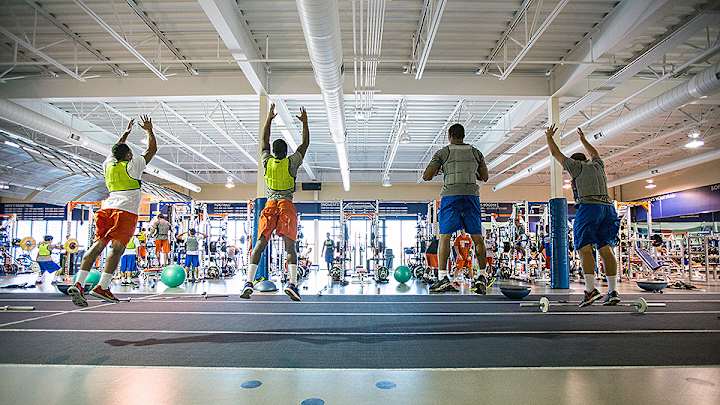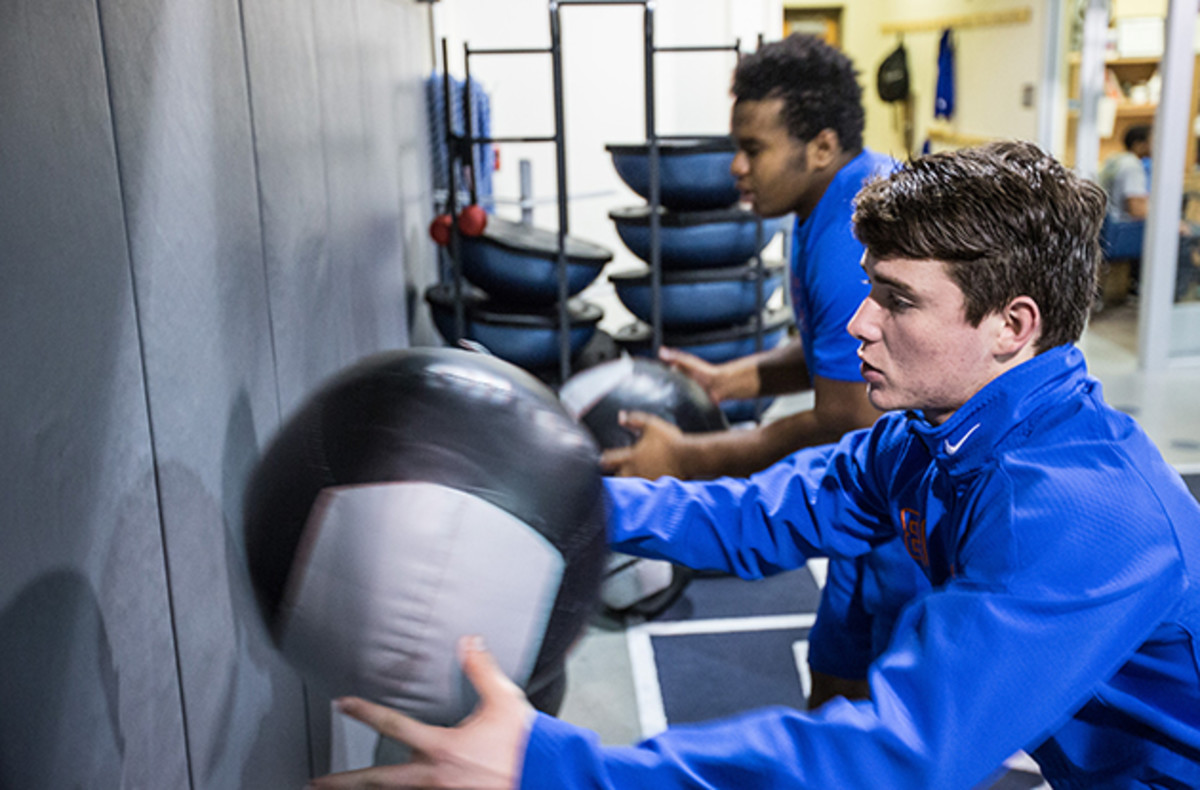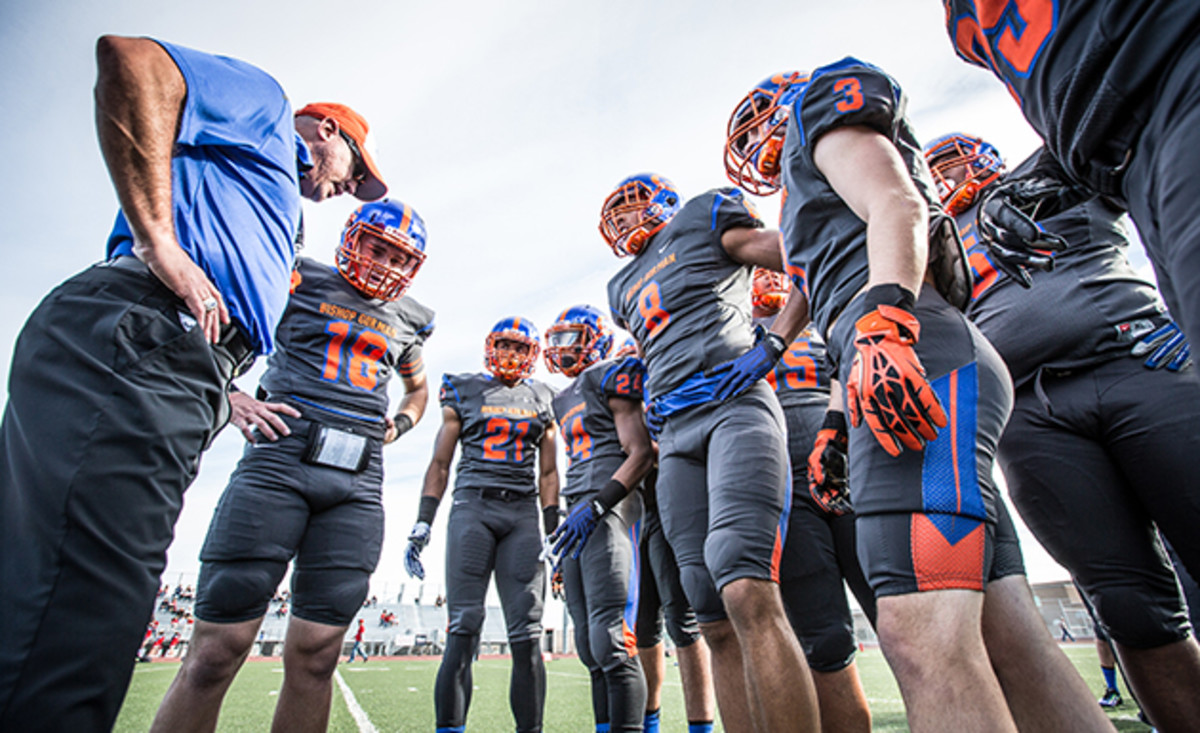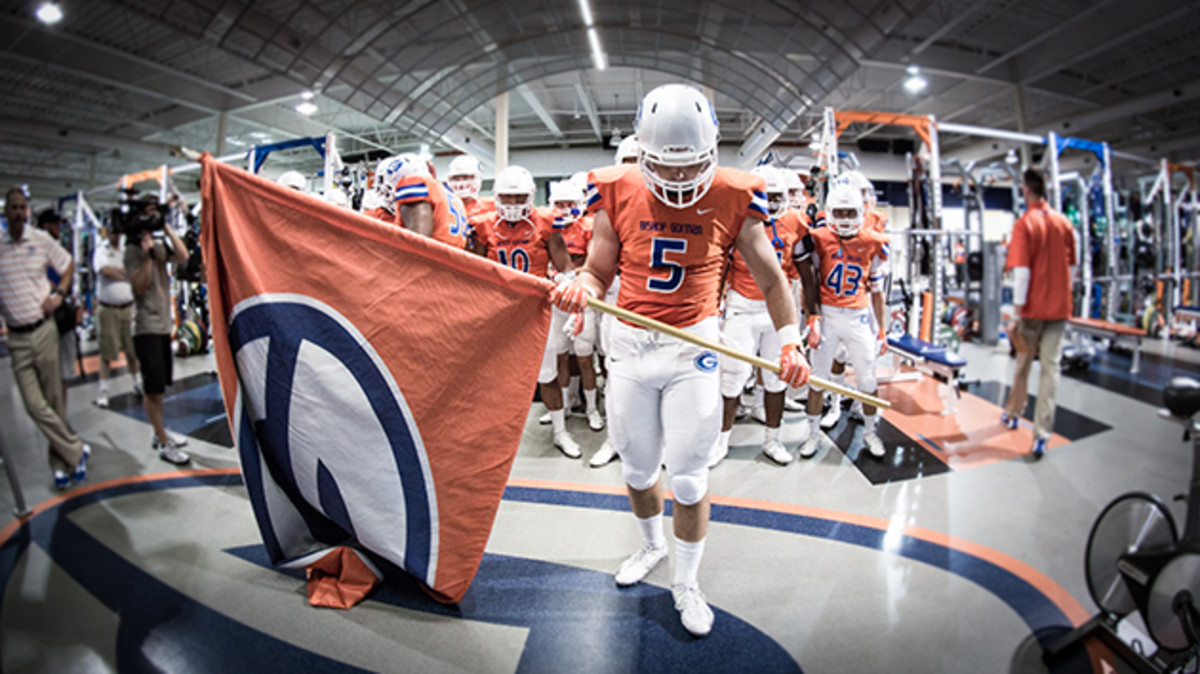Intense lifting is building Bishop Gorman football into national power

The Bishop Gorman High Gaels have amassed six straight Nevada state football championships—as great a run as any seen in Las Vegas, on or off The Strip. But what’s behind such success? For USA Today’s No. 1 ranked squad, the program’s strength begins with…strength.
“Any team that wants to a compete for a championship at any level has to have not a good strength program, but a great one,” head coach Kenneth Sanchez tells SI Edge. “And that’s what we have here at Bishop Gorman. It’s the foundation in which our house here at Gorman is built on.”

The French Contrast strength and conditioning method, originally developed by French sports scientist Gilles Cometti, combines complex (a high load lifting set and plyometric exercise) and contrast methods (a near-maximal load, followed by a lighter sub-maximal load performed as one set), and has become a pivotal pie-slice in Bishop Gorman’s strength development—thanks to strength and conditioning coach Sean Manuel.
“It takes advantage of high motor unit recruitment using heavy weight, then using plyometrics to stimulate the nervous system, then using light weight at high speeds, followed by an over-speed movement,” says Manuel, who is a National Strength and Conditioning Association (NSCA) Certified Strength and Conditioning Specialist (CSCS). “French Contrast, done properly, trains the body to produce greater power outputs, creating a more explosive athlete.”
Driven by success: Why getting to the next level is all in your head
Manuel, who just completed his fifth successful season at Bishop Gorman, began initiating the French Contrast protocol last season, as an avenue to break away from common weight room strength training. “This has been an evolution,” says the two-time American Football Monthly national high school strength coach of the year. “We used to use a basic linear progression (light to heavy). Then I started to research an undulating block method after reading Cal Dietz’s Triphasic Training book. It made a lot of sense and that’s when I started experimenting with the French Contrast method.”
Before the Bishop Gorman players become eligible for the world of French Contrast training, they are taught body function basics—beginning each January for two to three months—and must meet intense criteria before graduating into the program’s advanced training. The prerequisite requires athletes to focus on corrective exercises, core strength, hip mobility training, proper functional movement patterns and general strength training, followed by a phase where they’re tested to see if they’ve made the cut.
“We work from a base where we develop stability and flexibility in the kids, as well as identify faulty movement patterns and muscular imbalances,” Manuel explains. “We work to correct these first, then we work to put size on the kids (hypertrophy). After gaining some size, we develop absolute strength and work to get the kids to lift 1.5 to 2 times their bodyweight on the squat, and .75 to 1.25 times their bodyweight on the bench. Once we hit these strength [markers] we turn to French Contrast methods.”
It’s generally observed that most players performing French Contrast have a prior two years of strength training experience, but the genetic freaks are advanced forward after one.

“Freshmen and sophomores usually don’t go into French Contrast,” Manuel says. “Those who don’t, stay in the strength phase to get them to reach the markers.”
The team’s French Contrast approach begins with a squat exercise (1-2 repetitions, 80-90% of a 1 repetition maximum), followed by a plyometric movement (3-6 repetitions) of either box jumps, drop squat jumps, hurdle jumps, split jumps or depth jumps.
“The key to creating dynamic movement patterns is focusing on the reactive eccentric drop followed by the explosive concentric secondary action,” Manuel says. “You want to drop like someone just pulled the lever on a trap door you are standing on. Then jump up as high and fast as you can.”
And that’s not all. Next comes a sub-maximal squat jump (3-6 repetitions, 20-40% of a 1 repetition maximum).
Fitness Foremost: A beginner's guide to starting your own workout routine
“French Contrast has produced tremendous strength gains in our athletes,” says master personal trainer Robert Burgman, Bishop Gorman’s athletic training center coordinator. “We have measured their gains in rate of force development (RFD) and it was greatly increased over previous years due to the recruitment of specific muscle fibers.”
Finally, the players are required to execute over-speed assisted band jumps (4-8 repetitions), performed by attaching resistance bands to the squat rack. The four French Contrast modules are merged into a single circuit, consisting of three sets and a three to five minute rest between each set.
“I went, ‘Oh yeah, this is it,’” Manuel says about French Contrast. “People only become fast when they move fast. This last year showed up the biggest. From a strength coach’s perspective, I‘m ecstatic about their growth.”
Interestingly, Bishop Gorman’s program also stresses safety in a football world that’s well-known for its concussion-stricken past. Each year, U.S. emergency departments treat over 173,000 traumatic brain injuries in children and adolescents, according to the Centers for Disease Control and Prevention (CDC). The CDC also states that traumatic brain injuries are highest in high school football at 55,007 (.47 per 1,000 athlete exposures).

“We do impact testing on every [athlete] to establish a base score,” Manuel says. “You are not allowed to continue to compete on the team unless you have done it. Once a baseline is established, it’s filed away for later reference. Then, if a [player] is suspected of having a concussion, they [are tested] again to see the degree of deviation from the original score. A certain amount of deviation from the original score means there is a high probability that [the player’s] concussed. At that point, he is held out until his impact scores go back to baseline.”
So how do the athletes feel about what may be arguably the pinnacle of high school football strength and conditioning programs in the country? Just ask the 2014 Nevada State rushing title holder, senior Russell Booze.
“Bishop Gorman's strength and conditioning program has contributed to my success and overall fitness by giving me a constant challenge with every weightlifting workout, stretch and plyometric,” says Booze, a 5'11", 185-pound running back, who finished the season with 1,791 rushing yards and 23 touchdowns. “The competitive atmosphere among my teammates and I brought out each of our highest peaks, as far as flexibility, speed and strength for the season.”
“The workouts we did exercised body parts that I didn't even know could be targeted, which would improve the bigger muscle groups,” Booze continues. “The demanding presence that Coach [Manuel] had upon us kept us focused, disciplined and healthy throughout the season. This mindset was also applied on the field with the other coaches which led to our undefeated season and number one national ranking.”
